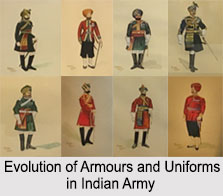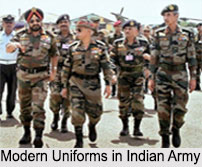 Evolution of Armours and Uniforms in Indian Army can be traced from the earliest days of "John Company" until 1947. The uniform of the Indian army was a wonderful, dramatic, sometimes fantastic, yet in many cases sensitive and practical compromise between the best of India and British military clothing.
Evolution of Armours and Uniforms in Indian Army can be traced from the earliest days of "John Company" until 1947. The uniform of the Indian army was a wonderful, dramatic, sometimes fantastic, yet in many cases sensitive and practical compromise between the best of India and British military clothing.
The Indian Army is the organization where every man is a potential leader. An army man is uniquely identified by three things from the civilians - their haircut, the way they carry themselves and the uniform. The main reason for clothing an Indian army in uniform is to provide it with the means of identification in the widest sense to distinguish one country"s forces from that of another in a narrower context and to identify individual units within an army. Today, there are various uniforms of Indian Army which are worn by them during occasions and posting of their service.
Uniforms of Indian Army during British Rule
Red was the colour chosen for most units of the East India Company"s armed forces. One possible reason was that the colour predominated in the British Army, thus making an ultra-visible link between the company troops and the King"s regiment serving in India.
Reforms in uniform were recommended for most constant of reasons, economy and the health of the soldiers. The East India Company needed soldiers with uniforms to distinguish them from troops of the sub-continent"s indigenous rulers, as also to impress upon its many enemies that "John Company" forces were vastly superior to those of the French, Portuguese and Dutch.
 However, in 1760 the artillery Lascars (Gunners) of the Bombay army wore Royal Regiment of Artillery colours of Blue with red facings which were a true British army tradition. There were a few exceptions to the red uniforms other than in the artillery; these included the corps of Bengal Pioneers, who wore a green uniform with green facings. By 1820, all the company"s native cavalry were clad in French Grey, Short and Frogged Jackets of the British Light Dragoon or Hussar type. With very few special considerations to the climate of India, the European officers kept up a proper appearance in the British pattern uniform.
However, in 1760 the artillery Lascars (Gunners) of the Bombay army wore Royal Regiment of Artillery colours of Blue with red facings which were a true British army tradition. There were a few exceptions to the red uniforms other than in the artillery; these included the corps of Bengal Pioneers, who wore a green uniform with green facings. By 1820, all the company"s native cavalry were clad in French Grey, Short and Frogged Jackets of the British Light Dragoon or Hussar type. With very few special considerations to the climate of India, the European officers kept up a proper appearance in the British pattern uniform.
In the 1980s, the Indian Army first adopted Disruptive Pattern (DP) battle dress. Since cotton uniforms faded quickly, the battle dress was made of polyester, an uncomfortable choice in India"s tropical conditions. But even then the colours lightened because the design was printed. The army-issued uniforms faded and tore quickly, so troops were forced to go to the market and shop for their fabric.
The second change in the uniforms of the Indian Army was when it moved from khaki to olive green after Independence to distinguish it from the Pakistani Army. By 2005 the army, which had made several unsuccessful attempts over the years to prevent over-the-counter sales of its DP design, was planning to discard its two-decade-old battle dress. This was the third major uniform shift.
Thus, the Indian Army has a large amount of variation in its uniforms, with differentiating waistbands, turbans and other headgear colours denoting what regiment the solider is a part of.






